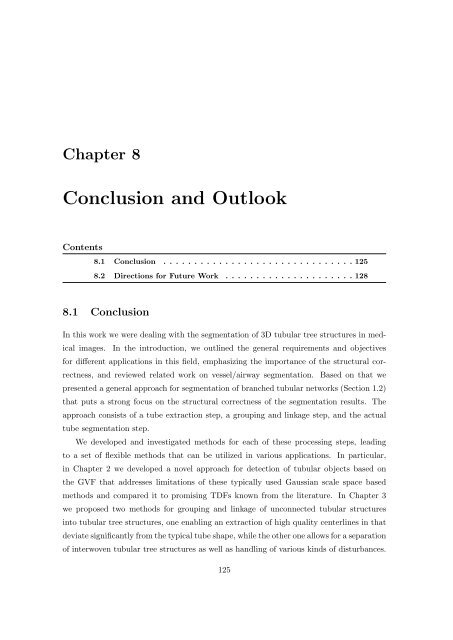Segmentation of 3D Tubular Tree Structures in Medical Images ...
Segmentation of 3D Tubular Tree Structures in Medical Images ...
Segmentation of 3D Tubular Tree Structures in Medical Images ...
Create successful ePaper yourself
Turn your PDF publications into a flip-book with our unique Google optimized e-Paper software.
Chapter 8<br />
Conclusion and Outlook<br />
Contents<br />
8.1 Conclusion . . . . . . . . . . . . . . . . . . . . . . . . . . . . . . . 125<br />
8.2 Directions for Future Work . . . . . . . . . . . . . . . . . . . . . 128<br />
8.1 Conclusion<br />
In this work we were deal<strong>in</strong>g with the segmentation <strong>of</strong> <strong>3D</strong> tubular tree structures <strong>in</strong> medical<br />
images. In the <strong>in</strong>troduction, we outl<strong>in</strong>ed the general requirements and objectives<br />
for different applications <strong>in</strong> this field, emphasiz<strong>in</strong>g the importance <strong>of</strong> the structural correctness,<br />
and reviewed related work on vessel/airway segmentation. Based on that we<br />
presented a general approach for segmentation <strong>of</strong> branched tubular networks (Section 1.2)<br />
that puts a strong focus on the structural correctness <strong>of</strong> the segmentation results. The<br />
approach consists <strong>of</strong> a tube extraction step, a group<strong>in</strong>g and l<strong>in</strong>kage step, and the actual<br />
tube segmentation step.<br />
We developed and <strong>in</strong>vestigated methods for each <strong>of</strong> these process<strong>in</strong>g steps, lead<strong>in</strong>g<br />
to a set <strong>of</strong> flexible methods that can be utilized <strong>in</strong> various applications. In particular,<br />
<strong>in</strong> Chapter 2 we developed a novel approach for detection <strong>of</strong> tubular objects based on<br />
the GVF that addresses limitations <strong>of</strong> these typically used Gaussian scale space based<br />
methods and compared it to promis<strong>in</strong>g TDFs known from the literature. In Chapter 3<br />
we proposed two methods for group<strong>in</strong>g and l<strong>in</strong>kage <strong>of</strong> unconnected tubular structures<br />
<strong>in</strong>to tubular tree structures, one enabl<strong>in</strong>g an extraction <strong>of</strong> high quality centerl<strong>in</strong>es <strong>in</strong> that<br />
deviate significantly from the typical tube shape, while the other one allows for a separation<br />
<strong>of</strong> <strong>in</strong>terwoven tubular tree structures as well as handl<strong>in</strong>g <strong>of</strong> various k<strong>in</strong>ds <strong>of</strong> disturbances.<br />
125















